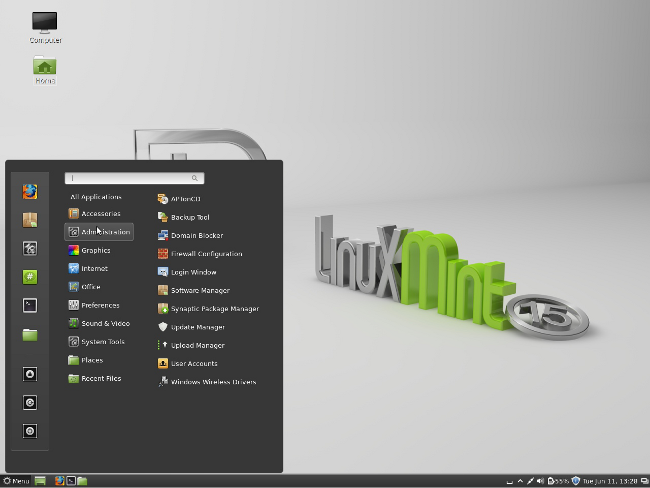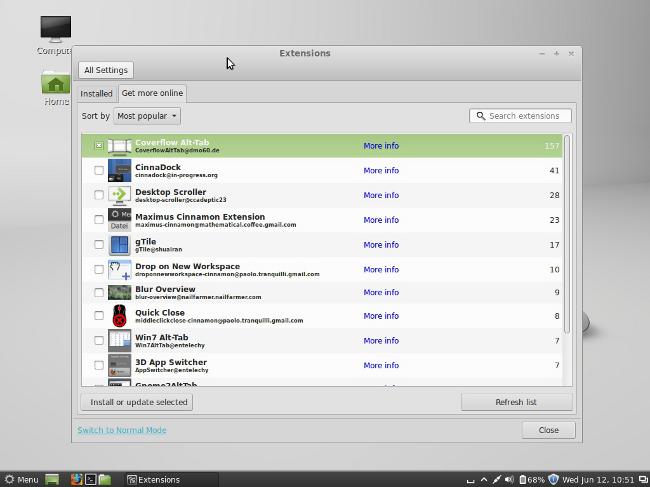Original URL: https://www.theregister.com/2013/06/26/mint_15_freshens_ubuntus_bad_bits/
Mint 15 freshens Ubuntu's bad bits
Slipping between GNOME and Unity sheets with Olivia
Posted in OSes, 26th June 2013 11:16 GMT
Review Mint is a relative newcomer to the world of popular desktop distros, but it has recently started to take the GNOME and Unity-hating Linux world by storm.
The recent release of version 15, called Olivia, should help it secure a reputation as “the” alternative desktop. If you'd like a modern set of desktop tools without a completely new desktop interface to go with, then Mint 15 has what you're after.
Mint is a very consumer-oriented distro offering respite for the many users unhappy with Ubuntu's Unity desktop on one side and GNOME Shell on the other. Mint still uses Ubuntu as its starting point (Ubuntu 13.04 for Mint 15), but strips out Unity in favour of Mint's own desktops. Also note that, somewhat confusingly, there's also a Debian-based version of Mint, but it uses a "semi-rolling" schedule based on Debian's testing release.
There are two flavours of the Ubuntu-based Mint 15: the older, more stable MATE desktop, which is a fork of good old GNOME 2, and Cinnamon. That started life as a GNOME fork as well, but is now in the process of forging its own path. Both releases have been updated for Mint 15, but it's the Cinnamon release that's the far more noteworthy of the two.

Don't stop the Start Button: an interface Windows 7 users will recognize
Cinnamon does a nice job of sitting in the middle of what we used to have - the relatively mundane, but stable world of GNOME 2.x - and the new world of seemingly anything-goes desktops. In fact, Linux though it may be, the Cinnamon desktop will likely seem more familiar for Windows 7 users than Windows 8, which also eschews the traditional start-button based desktop.
Mint 15 ships with Cinnamon 1.8, what many would consider the first truly stable release of the nascent Cinnamon desktop. This version boasts some 1,000 changes and bug fixes since the last release and brings several major new features like a unified settings panel, support for widgets ("Desklets" in Cinnamon parlance) and the new MintSources and MintDrivers tools for managing software repositories and drivers respectively.
The MintSources package manager replaces the Ubuntu Software Center and, while it may not look quite as slick, it doesn't hide packages (because they're too "technical" in Ubuntu's view) and it offers a handy speed test to help you find the fastest mirror for downloading. MintSources can also handle PPAs, third-party repositories and authentication keys.
The DriverManager is a standalone app that makes it easy to install 3rd-party hardware drivers like Nvidia binaries or Nouveau drivers as well as wireless and other hardware drivers. It also helpfully lets you know if you're using any proprietary drivers.
This release sees Cinnamon's file manager, Nemo, getting a much-needed make over with some useful new features like the ability to quickly hide the sidebar via a new button on the bottom bar (or F9) and easily switch between the sidebar's places view and the straight folder hierarchy view. There's also a much easier to access file path dialog for keyboard junkies. Nemo also now sports what are known as actions - by placing an action file in /usr/share/nemo/actions you can add items to Nemo’s right-click context menu.
Mint gets MATE
Cinnamon 1.8 offers a much better integrated system settings panel. Previously some system settings were part of the Cinnamon system setting panel and some the GNOME settings panel, which was confusing and annoying. Thankfully, everything is in one place now. The panel itself is largely unchanged, but given that one of the major appeals of Mint over desktops like Unity or GNOME Shell is the ease of customization, the unification gives Cinnamon a much more focused, integrated feel and will go a long way toward helping newcomers get to terms with the desktop and tweak it to their liking.
Another nice new bit of integration in this release involves what Cinnamon calls "Spices" - little applets, desklets, themes and extensions that enhance the desktop. Previously Spices were downloaded from a website and installing them was a manual process. In Cinnamon 1.8 the process of finding and installing Spices is all handled within the "extensions" pane of the Cinnamon settings panel.

A Cinnamon extensions pane helps spice up your desktop
Other new Cinnamon features include a screensaver that allows for personalized messages and support for "desklets", which are essentially desktop widgets. This release ships with a scant three, which you can find by right-clicking the desktop and selecting the desklets menu item. That will open a panel with a clock, a photo frame and a launcher. A few more can be found by hitting the "Find More Online" button, including an XKCD widget, but look for more desklets options to show up once the community gets to work.
The Mint team also has some new features for those who prefer the MATE desktop. Adhering much more to the look and feel of GNOME 2.x, MATE offers an alternative to GNOME 3's fallback mode. Mint 15 ships with MATE 1.6, which doesn't look all that different from its predecessors, but offers a ton of under-the-hood improvements. The file manager has been slightly overhauled, offering some of the same sidebar features found in Nemo, and there are some new settings options as well.
Mint 15 is all about polish, not just in Cinnamon and MATE, but in everything from the login screen, which can now be customized with themes that use simple HTML and CSS, to the installation menu which helpfully offers to encrypt your disk and install LVM tools if you'd like them.
Mint also packages a few apps you won't find in most distros - extras like VLC and GIMP are included along with standards like Firefox, Thunderbird and LibreOffice. There are two ways to look at that: some will like it since it means you don't have to go download the apps yourself, though others will no doubt think of it as bloatware.
That's the good news for Mint 15. The bad news is that Mint is a very young distro and thus far it tends to take Ubuntu releases part and parcel. Bugs in Ubuntu will hit Mint as well, which means at least some of Mint's appeal - that it's improving on Ubuntu - is lost. It's also a little unclear whether Mint is planning to follow Ubuntu, as the older distro moves further and further away from the Linux mainstream.
While some aspects of Mint's future may be uncertain, for now the Mint project continues to churn out impressive releases. Mint 15 has been rock solid in my testing. It even runs quite well on my underpowered EeePC netbook.
Indeed, Mint 15 manages to succeed at what the Mint project set out to do - take what's good about Ubuntu, fix what's bad about it and add a little polish on top. While previous releases have shown promise, Mint 15 is the first to really deliver on those goals. If the world of GNOME Shell and Unity leave you feeling cold, Mint 15 just might offer a solution. ®